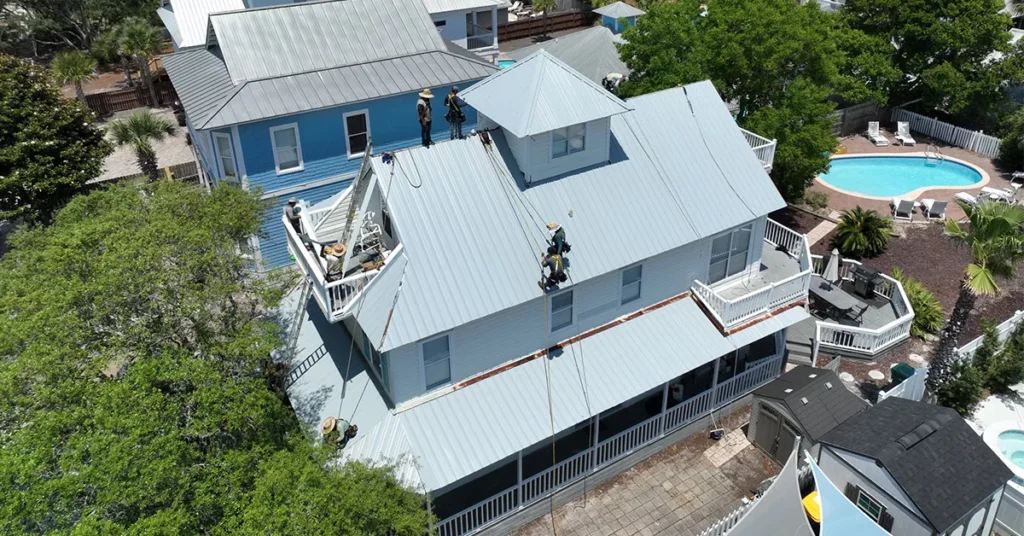Your roof is one of the most critical components of your home, shielding you and your family from rain, wind, snow, and harsh sunlight. But like any other part of your home, it requires regular care to stay in top condition. Ignoring roof maintenance can lead to costly repairs, structural damage, and even health hazards like mold growth. Whether you’re a homeowner or managing a commercial property, understanding the importance of commercial roof maintenance and roofing maintenance can save you time, money, and stress in the long run.
In this blog, we’ll explore why regular roof maintenance matters, what it involves, and how you can keep your roof in excellent shape year-round. Let’s dive in!
The Importance of Regular Roof Maintenance
Your roof is constantly exposed to the elements, which means it’s prone to wear and tear over time. Regular roof maintenance helps identify and address minor issues before they escalate into major problems. Here’s why it’s so important:
Prevents Costly Repairs: Small issues like cracked shingles roof or clogged gutters can lead to significant damage if left unattended. Regular maintenance helps catch these problems early.
Extends Roof Lifespan: A well-maintained roof can last decades, while neglect can shorten its life significantly.
Protects Your Home’s Interior: A damaged roof can lead to leaks, which can ruin ceilings, walls, and even your belongings.
Boosts Energy Efficiency: Properly maintained roofs with good insulation and ventilation can reduce heating and cooling costs.
Enhances Curb Appeal: A clean, well-kept roof improves the overall appearance of your home or commercial property.
Roof Maintenance Checklist
To help you stay on top of your roof’s health, here’s a simple checklist for roofing maintenance. These tasks can be divided into seasonal care, regular inspections, and smart practices.
Seasonal Roof Care
- Clean Gutters: Clogged gutters can cause water to back up and damage your roof. Clean them at least twice a year, especially in the fall and spring.
- Trim Overhanging Branches: Tree branches can scratch and damage shingles. Keep them trimmed to prevent this.
- Remove Debris: Leaves, twigs, and other debris can trap moisture and lead to rot. Clear them off your roof regularly.
- Check for Moss and Algae: These can damage shingles and create unsightly stains. Use a gentle cleaning solution to remove them.
Regular Inspections
- Inspect Shingles: Look for cracked, curled, or missing shingles and replace them as needed.
- Check Flashing: Flashing around chimneys, vents, and skylights can wear out over time. Ensure it’s intact and properly sealed.
- Examine Attic Ventilation: Proper ventilation prevents moisture buildup and extends your roof’s lifespan.
- Look for Water Stains: Stains on ceilings or walls can indicate a leaky roof. Address them immediately.
Smart Practices
- Limit Foot Traffic: Walking on your roof can damage shingles. Hire a professional for inspections and roof repairs.
- Ensure Proper Drainage: Make sure downspouts direct water away from your home’s foundation.
- Schedule Professional Inspections: A roofing contractor can spot issues you might miss and provide expert solutions.
FAQs
How often should I schedule roof maintenance?
For most homes, roof maintenance should be done at least twice a year, typically in the spring and fall. Commercial properties may require more frequent checks due to their size and complexity.
Can I perform roof maintenance myself?
While some tasks like cleaning gutters or removing debris can be DIY, it’s best to hire a professional for inspections and repairs. They have the expertise and equipment to do the job safely and effectively.
What are the signs that my roof needs maintenance?
Look for cracked or missing shingles, water stains on ceilings, sagging areas, or excessive granule loss in gutters. These are all signs that your roof needs attention.
Is commercial roof maintenance different from residential?
Yes, commercial roof maintenance often involves larger, more complex roofing systems. It may require specialized equipment and more frequent inspections to ensure compliance with safety standards.
How does regular maintenance save money?
By addressing small issues early, you can avoid costly repairs or even a full roof replacement. Regular maintenance also extends your roof’s lifespan, saving you money in the long run.
Conclusion
Your roof is more than just a protective barrier—it’s an investment in your home’s safety, comfort, and value. Regular roof maintenance is the key to ensuring it stays in excellent condition for years to come. By following a simple checklist and scheduling professional inspections, you can prevent costly repairs, extend your roof’s lifespan, and enjoy peace of mind knowing your home is well-protected.
Don’t wait for a leak or storm damage to remind you of your roof’s importance. Take proactive steps today to keep it in top shape. Whether you’re a homeowner or managing a commercial property, prioritizing roofing maintenance is a decision you won’t regret.


